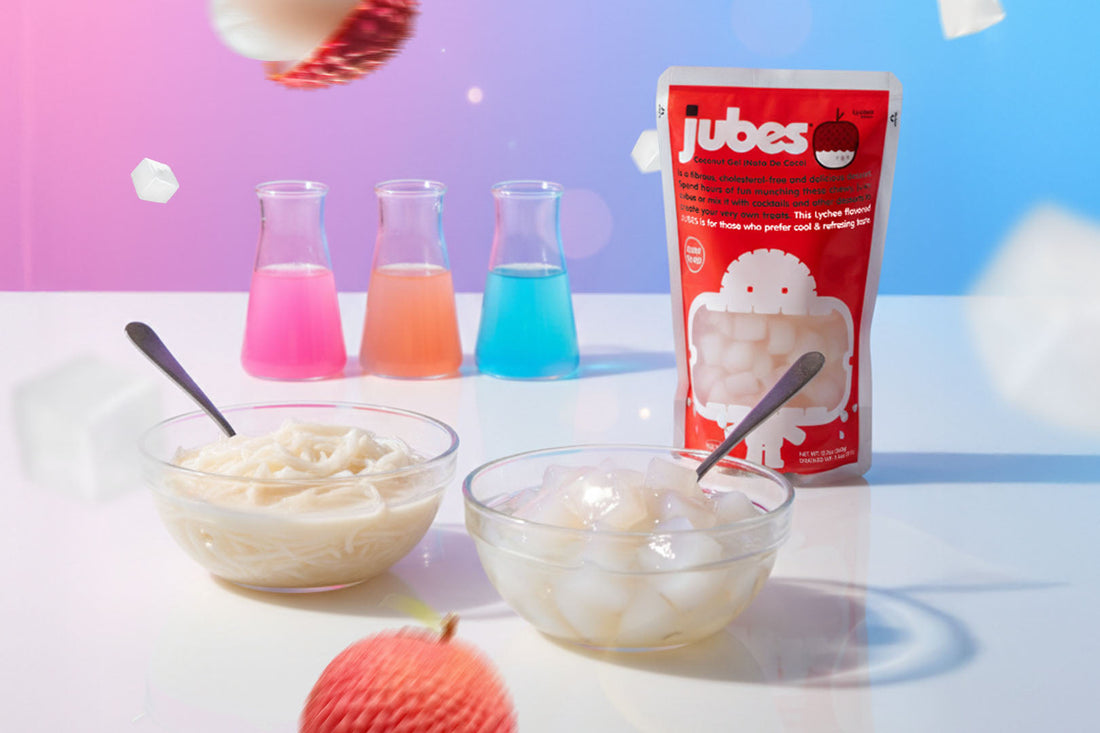Key Highlights
- Tropical Duo: A creamy macapuno base meets the chewy delight of Jubes nata de coco for a fun, textural dessert experience.
- Texture Harmony: Silky coconut strands blend with bouncy nata cubes, creating a contrast that’s satisfying and indulgent.
- Cultural Classic: A beloved pair in Filipino desserts, often featured in halo-halo, ice creams, and festive sweets.
- Versatile Pairing: Enjoy them on their own or add to puddings, parfaits, and beverages for a refreshing coconut twist.
Introduction
Have you ever wanted to add a tropical twist to your desserts? Imagine combining the rich, creamy texture of a special coconut with fun, chewy jelly cubes. This is the magic of pairing macapuno with Jubes nata de coco. These two ingredients are staples in Filipino desserts for a reason. They create a delightful experience of flavors and textures that can turn any simple sweet into an exotic treat. Let’s explore these fantastic coconut products and how you can use them to create fun desserts.
Fast Facts: Macapuno and Jubes Coconut Gel
So, what exactly is macapuno? It's a special variety of coconut that, due to a natural genetic mutation, is filled with soft, jelly-like meat instead of the hard flesh and water you find in a regular coconut. This unique texture makes it a prized ingredient for coconut treats.
On the other hand, Jubes are a brand of nata de coco, which are chewy, translucent coconut gel cubes. Unlike macapuno, which is the coconut’s meat, these coconut jelly cubes are made from fermented coconut water. Together, they represent two delicious but different ways to enjoy coconut.
|
Feature |
Macapuno Coconut |
Jubes Coconut Gel (Nata de Coco) |
|---|---|---|
|
Origin |
Naturally occurring coconut variety from the Philippines |
Created in the Philippines through the fermentation of coconut water |
|
Made From |
The coconut’s flesh (soft, jelly-like meat) |
Fermented coconut water transformed into chewy gel cubes |
|
Texture |
Thick, creamy, custard-like |
Firm, bouncy, and chewy |
|
Flavor Profile |
Mildly sweet, rich, and nutty |
Lightly sweet with a refreshing coconut note |
|
Appearance |
Opaque white, solid throughout, little to no coconut water inside |
Translucent cubes often soaked in syrup for added sweetness |
|
Rarity |
Naturally rare due to a genetic mutation in the coconut’s endosperm |
Widely available and mass-produced for everyday use |
|
Culinary Uses |
Used in traditional Filipino desserts like macapuno balls, buko pandan, and ice cream |
Found in fruit salads, bubble tea, puddings, parfaits, and drinks |
|
Cultural Significance |
Considered a delicacy and symbol of celebration in Filipino cuisine |
A fun, modern dessert ingredient popular across Asia and the U.S. |
|
Fun Fact |
Formed by a rare natural mutation that replaces coconut water with jelly-like flesh |
Created by a bacterial culture (Acetobacter xylinum) that turns coconut water into microbial cellulose |
Understanding Macapuno: The Special Coconut
Macapuno (Cocos nucifera L. var. macapuno) is more than just a coconut, it’s a culinary treasure of the Philippines. Naturally occurring and genetically unique, macapuno stands out for its soft, jelly-like flesh and creamy texture. For generations, it has been a symbol of luxury and celebration in Filipino cuisine.
Its rarity and delicate characteristics have made it a prized ingredient across Southeast Asia. Let’s explore what makes macapuno so special, how it’s cultivated, and why it remains a beloved part of Filipino desserts.
Unique Properties of Macapuno Coconut
The defining feature of macapuno is its soft, custard-like meat. Unlike the firm, crunchy flesh of regular coconuts, macapuno’s meat is gelatinous and creamy, perfect for creating smooth desserts, jams, and fillings.
Another standout trait is the absence of coconut water. Regular coconuts contain liquid at the center, but macapuno’s abnormal growth fills this cavity with dense, jelly-like flesh. This makes macapuno ideal for recipes that emphasize texture and richness rather than liquid content.
In flavor, macapuno is mildly sweet and nutty, allowing it to blend effortlessly with other dessert ingredients. This combination of creamy texture and subtle flavor is what sets macapuno apart as one of nature’s most unique variations of coconut.
How Macapuno Is Cultivated and Harvested
Historically, macapuno coconuts were rare and unpredictable, a single tree might produce only a few special nuts by chance. That changed in the 1960s when Filipino scientist Dr. Emerita de Guzman pioneered an embryo-culture technique that allowed consistent propagation of macapuno-bearing trees. Even today, macapuno remains a specialty crop that requires careful cultivation in tropical climates. Farmers identify macapuno nuts by tapping them. The solid, dull sound indicates the coconut is filled with gelatinous flesh rather than water.
The cultivation of macapuno is a delicate and specialized process that requires both science and care. Propagation begins with modern embryo-culture methods, developed to ensure that coconut trees consistently produce macapuno nuts. Once planted, the trees need warm tropical conditions, balanced humidity, and attentive farm management to thrive. Despite advances in cultivation, macapuno remains rare, as not every tree yields these special coconuts. This scarcity continues to make macapuno one of the most prized varieties in the world.
Spotlight on Jubes Coconut Gel
Let's shift the spotlight to another fantastic coconut product: nata de coco. These fun, chewy coconut jelly cubes are a favorite addition to many drinks and desserts across Asia. Jubes coconut gel is a popular, ready-to-use version of this treat.
While also derived from coconut, nata de coco offers a textural experience that is the complete opposite of creamy macapuno. Understanding its unique origins and uses helps explain why it’s such a beloved ingredient in its own right.
Origins and Preparation of Nata de Coco
So, what is nata de coco made from? Nata de coco, which translates to “cream of coconut,” was first developed in the Philippines as a creative way to make use of coconut water, the clear liquid found inside young coconuts. Unlike macapuno, which comes from the coconut’s meat, nata de coco is made entirely from fermented coconut water.
The process begins when a bacterial culture (Acetobacter xylinum) is introduced into sweetened coconut water. Over time, the bacteria consume the sugars and form a thick, jelly-like cellulose layer on the surface. Once this gel reaches the desired firmness, it’s harvested, washed thoroughly to remove any acidity, and then cut into small cubes.
To enhance its mild flavor, the cubes are typically soaked in light syrup, creating the chewy, translucent, and subtly sweet coconut gel we know today. The result is a refreshing, plant-based ingredient that adds texture and tropical flavor to a wide variety of desserts, fruit salads, bubble teas, and even cold beverages.
Combining Macapuno and Nata de Coco for Fun Desserts
Now for the best part bringing these two amazing coconut treats together. The creamy richness of macapuno and the chewy texture of Jubes nata de coco make the perfect combination for creating exciting traditional desserts with a modern twist. This pairing is not just delicious; it’s a beautiful reflection of Filipino culture, where coconut-based sweets are central to many family gatherings and Filipino celebrations.
Blending macapuno and Jubes cubes adds contrast and harmony to your favorite quick dessert recipes. The soft, custard-like coconut meat complements the chewy nata jelly, giving each bite a mix of creaminess and bounce. Whether you’re layering them into puddings or mixing them into fruit salads, this duo guarantees that every spoonful feels tropical and indulgent.
Recipe Ideas Using Macapuno Coconut and Jubes Coconut Gel
Looking for easy ways to enjoy both macapuno and nata de coco jelly? Here are a few quick dessert recipes to try:
- Tropical Parfait: Layer macapuno preserves, Jubes cubes, and crushed graham crackers with whipped cream for an elegant no-bake treat.
- Fruit Salad Supreme: Mix macapuno, nata de coco lychee, and seasonal fruits in a creamy coconut milk dressing for a nostalgic Filipino dessert.
- Ice Cream Topping: Spoon macapuno and Jubes coconut gel over vanilla or ube ice cream for a chewy, creamy finish.
- Halo-Halo Mix-In: Both macapuno and nata jelly are essentials in halo-halo, the beloved Filipino shaved ice dessert.
- Coconut Pudding Delight: Stir Jubes nata de coco into coconut milk pudding for added texture and subtle sweetness.
Health Benefits of Macapuno and Nata de Coco
Beyond their incredible taste, both macapuno and nata de coco offer nutritious benefits. As coconut-based products, they can be a smarter alternative to processed sweets, especially when enjoyed in moderation.
Nutritional Highlights of Macapuno Coconut
Macapuno, rich in natural coconut milk fats and fiber, provides energy through healthy medium-chain triglycerides (MCTs). These fats are easily digested and can boost metabolism. The soft coconut meat also contains dietary fiber, potassium, and magnesium, nutrients that support digestive health and hydration.
When prepared with less added sugar, macapuno becomes a wholesome ingredient that enhances desserts while still offering nutritional value. It’s proof that indulgence can be balanced with wellness.
Wellness Advantages of Nata de Coco-Based Treats
Meanwhile, nata de coco jelly is mostly made of dietary fiber and water, making it naturally low in calories and fat-free. This high fiber content promotes healthy digestion and helps you feel full longer, making it an ideal light treat after meals.
Choosing Jubes cubes packed in light syrup or fruit juice ensures you enjoy all the chewy goodness of nata de coco lychee with less added sugar. Whether in fruit salads, beverages, or puddings, this makes Jubes a fun and smart way to satisfy your sweet cravings.
Conclusion
In summary, macapuno and Jubes Nata de Coco form a perfect tropical pairing that captures the heart of traditional Filipino desserts. Whether you’re recreating family favorites or crafting new easy dessert recipes, macapuno and Jubes cubes make every dish special. Try them in fruit salads, puddings, and even Thanksgiving dessert ideas for a fun, tropical twist. Don't forget to share your favorite dessert creations on social media, and inspire others to enjoy these delicious delights!
Frequently Asked Questions
Is macapuno related to nata de coco, or are they different products?
Macapuno and nata de coco are different products from the coconut. Macapuno is the soft, jelly-like meat of a special coconut variety. Nata de coco, on the other hand, is a chewy gel produced by fermenting coconut water.
What are some creative Thanksgiving dessert ideas using Jubes nata de coco?
Give your Thanksgiving table a tropical twist! Try adding Jubes nata de coco lychee to pumpkin mousse parfaits, cranberry jelly, or coconut milk panna cotta. It adds chewiness, shine, and a refreshing burst of flavor to traditional holiday desserts.
Where can I buy Jubes nata de coco in the United States?
You can find Jubes Nata de Coco in major Asian grocery stores like El Super, 99 Ranch Market, and H Mart. They’re also available online through Amazon directly from the distributor, Jans Enterprises Corp. For wholesale or distribution inquiries, visit JansFood.com.

